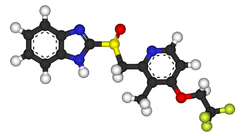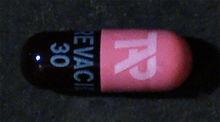Lansoprazole
 | |
 | |
| Clinical data | |
|---|---|
| Pronunciation | /lænˈsoʊprəzoʊl/ lan-SOH-prə-zohl |
| Trade names | Prevacid, others |
| AHFS/Drugs.com | Monograph |
| MedlinePlus | a695020 |
| License data |
|
| Pregnancy category | |
| Routes of administration | Oral, IV |
| ATC code | A02BC03 (WHO) |
| Legal status | |
| Legal status | |
| Pharmacokinetic data | |
| Bioavailability | 80% or more |
| Protein binding | 97% |
| Metabolism | Hepatic (CYP3A4- and CYP2C19-mediated) |
| Biological half-life | 1–1.5 hours |
| Excretion | Renal and fecal |
| Identifiers | |
| |
| CAS Number |
103577-45-3 |
| PubChem (CID) | 3883 |
| IUPHAR/BPS | 7208 |
| DrugBank |
DB00448 |
| ChemSpider |
3746 |
| UNII |
0K5C5T2QPG |
| KEGG |
D00355 |
| ChEBI |
CHEBI:6375 |
| ChEMBL |
CHEMBL480 |
| ECHA InfoCard | 100.173.220 |
| Chemical and physical data | |
| Formula | C16H14F3N3O2S |
| Molar mass | 369.363 g/mol |
| 3D model (Jmol) | Interactive image |
| Chirality | Racemic mixture |
| |
| |
| (verify) | |
Lansoprazole, sold under the brand name Prevacid among others, is a medication which inhibits the stomach's production of acid. There is not evidence that its effectiveness is different than that of other PPIs.[1] Lansoprazole, given through a nasogatric tube, effectively controls pH inside the stomach and is an alternative to intravenous pantoprazole in people who are unable to swallow solid-dose formulations.[2]
Lansoprazole is a proton-pump inhibitor (PPI) in the same pharmacologic class as omeprazole. Lansoprazole has been marketed for many years and is one of several PPIs available.[3] It is a racemic 1:1 mixture of the enantiomers dexlansoprazole (Dexilant, formerly named Kapidex) and levolansoprazole.[4] Dexlansoprazole is an enantiomerically pure active ingredient of a commercial drug as a result of the enantiomeric shift. Lansoprazole's plasma elimination half-life (1.5 h) is not proportional to the duration of the drug's effects to the person (i.e. gastric acid suppression).[5] The effects of the medication last for over 24 hours after it has been used for a day or more.[6]
It is manufactured by a number of companies worldwide under several brand names. In the United States, it was first approved by the Food and Drug Administration (FDA) in 1995.[7] Prevacid patent protection expired on November 10, 2009.[8][9]
Medical uses
Lansoprazole is used for treatment of:
- Ulcers of the stomach and duodenum, and NSAID-induced ulcers
- Helicobacter pylori infection, alongside antibiotics (adjunctive treatment), treatment to kill H. pylori causing ulcers or other problems involves using two other drugs besides lansoprazole known as "triple therapy", and involves taking twice daily for 10 or 14 days lansoprazole, amoxicillin, and clarithromycin
- Gastroesophageal reflux disease
- Zollinger-Ellison syndrome[6]
There is no good evidence that it works better than other PPIs.[1]
Side effects
Side effects of PPIs in general[10] and lansoprazole in particular[11] may include:
- Common: diarrhea, abdominal pain[12]
- Infrequent: dry mouth, insomnia, drowsiness, blurred vision, rash, pruritus
- Rarely and very rarely: taste disturbance, liver dysfunction, peripheral oedema, hypersensitivity reactions (including bronchospasm, urinary, angioedema, anaphylaxis), photosensitivity, fever, sweating, depression, interstitial nephritis, blood disorders (including leukopenia, leukocytosis, pancytopenia, thrombocytopenia), arthralgia, myalgia, skin reactions[13] including (erythroderma[14] Stevens–Johnson syndrome, toxic epidermal necrolysis, bullous eruption)
PPIs may be associated with a greater risk of hip fractures and Clostridium difficile-associated diarrhea.[6]:22
Interactions
Lansoprazole interacts with several other drugs, either due to its own nature or as a PPI.[15]
- PPIs reduce absorption of antifungals (itraconazole and ketoconazole) [16] and possibly increase digoxin in plasma
- Increases plasma concentrations of cilostazol (risk of toxicity)
Lansoprazole possibly interacts with, amongst other drugs:
- sucralfate
- ampicillin
- bisacodyl
- clopidogrel
- delavirdine
- fluvoxamine
- iron salts
- voriconazole
- aminophylline and theophylline
- astemizole
Availability

The lansoprazole molecule is off-patent and so generic drugs are available under many brand names in many countries;[17] there are patents covering some formulations in effect as of 2015.[18]
Since 2009, lansoprazole has been available over the counter (OTC) in the U.S. in a marketed by Novartis as Prevacid 24HR.[19][6][20] In Australia, it is marketed by Pfizer as Zoton.
Research
In vitro experiments have shown that lansoprazole binds to the pathogenic form of tau protein.[21] As of 2015 laboratory studies were underway on analogs of lansoprazole to explore their use as potential PET imaging agents for diagnosing tauopathies including Alzheimer's disease.[21] Lansoprazole is also a prodrug that targets the cytochrome bc1 complex of Mycobacterium tuberculosis once converted to lansoprazole sulfide in mycobacterial host cells.[22]
References
- 1 2 "[99] Comparative effectiveness of proton pump inhibitors | Therapeutics Initiative". 28 June 2016. Retrieved 14 July 2016.
- ↑ Freston, James; Chiu, Yi-Lin; Pan, Wei-Jian; Lukasik, Nancy; Taubel, Jorg (2001). "Effects on 24-hour intragastric pH: a comparison of lansoprazole administered nasogastrically in apple juice and pantoprazole administered intravenously". The American Journal of Gastroenterology. 96 (7): 2058–2065. doi:10.1111/j.1572-0241.2001.03939.x. ISSN 0002-9270. PMID 11467632.
- ↑ http://www.patient.co.uk/showdoc/30002943/
- ↑ "Pharmacy Benefit Update". Retrieved 2 July 2014.
- ↑ "Prevacid Pharmacology, Pharmacokinetics, Studies, Metabolism". RxList.com. 2007. Retrieved April 14, 2007.
- 1 2 3 4 "Prevacid 24HR Label" (PDF). May 2010. Retrieved November 15, 2014.
- ↑ Mosby's Drug Consult: Lansoprazole
- ↑ Prevacid drug patents
- ↑ Teva to release Prevacid version when patent expires
- ↑ British National Formulary (Free registration required) 1.3.5 Proton pump inhibitors
- ↑ British National Formulary (Free registration required) Lansoprazole
- ↑ "Prevacid (Lansoprazole) Drug Information: Side Effects and Drug Interactions - Prescribing Information at RxList". RxList. Retrieved 2016-02-09.
- ↑ K C Singhal & S Z Rahman, Lansoprazole Induced Adverse Effects on the Skin, Indian Medical Gazette, July 2001, Vol. CXXXV. N0. 7: 223-225
- ↑ Sterry W, Assaf C (2007). "Erythroderma". In Bolognia JL. Dermatology. St. Louis: Mosby. p. 154. ISBN 1-4160-2999-0..
- ↑ British National Formulary (Free registration required) Lansoprazole interactions
- ↑ Piscitelli, S. C.; Goss, T. F.; Wilton, J. H.; d'Andrea, D. T.; Goldstein, H; Schentag, J. J. (1991). "Effects of ranitidine and sucralfate on ketoconazole bioavailability". Antimicrobial Agents and Chemotherapy. 35 (9): 1765–1771. PMC 245265
 . PMID 1952845.
. PMID 1952845. - ↑ drugs.com International availability of lansoprazole Page accessed February 3, 2015
- ↑ drugs.com Generic lansoprazole Page accessed February 3, 2015
- ↑ "Novartis launches Prevacid 24HR over-the-counter for full 24-hour frequent heartburn treatment" (PDF) (Press release). November 12, 2009. Retrieved November 13, 2009.
- ↑ "Novartis launches Prevacid 24HR over-the-counter for full 24-hour frequent heartburn treatment" (Press release). November 12, 2009. Retrieved November 13, 2009.
- 1 2 Villemagne, VL; Fodero-Tavoletti, MT; Masters, CL; Rowe, CC (January 2015). "Tau imaging: early progress and future directions.". The Lancet. Neurology. 14 (1): 114–24. doi:10.1016/s1474-4422(14)70252-2. PMID 25496902.
- ↑ Rybniker, Jan; et al. (July 2015). "Lansoprazole is an antituberculous prodrug targeting cytochrome bc1". Nature Communications. 6: 7659. doi:10.1038/ncomms8659. PMC 4510652
 . PMID 26158909.
. PMID 26158909.
External links
- Prevacid official website Takeda Pharmaceuticals North America
- Prevacid 24HR official website Novartis Consumer Health
- Prevpac official website Takeda Pharmaceuticals North America
- U.S. National Library of Medicine: Drug Information Portal - Lansoprazole